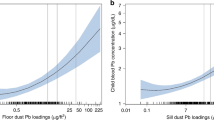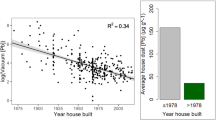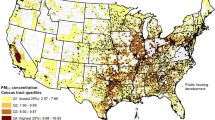Abstract
Background
Residentially derived lead pollution remains a significant problem in urban areas across the country and globe. The risks of childhood residence in housing contaminated with lead-based paint are well-established, but less is known about the effects of housing quality on adult lead exposure.
Objective
To evaluate the effects of residential-area housing age, vacancy status, and building quality on adult lead exposures.
Methods
We evaluated the effect of Census block group housing vacancy proportion, block group housing age, and in-person survey evaluated neighborhood building quality on serum levels of lead, mercury, manganese, and copper among a representative cohort of adults in Detroit, Michigan, from 2008–2013 using generalized estimating equations.
Results
Participants in Census block groups with higher proportions of vacant and aged housing had non-significantly elevated serum lead levels. We identified similar positive associations between residence in neighborhoods with poorer objectively measured building quality and serum lead. Associations between Census vacancies, housing age, objectively measured building quality, and serum lead were stronger among participants with a more stable residential history.
Significance
Vacant, aged, and poorly maintained housing may contribute to widespread, low-level lead exposure among adult residents of older cities like Detroit, Michigan. US Census and neighborhood quality data may be a useful tool to identify population-level lead exposures among US adults.
Impact
Using longitudinal data from a representative cohort of adults in Detroit, Michigan, we demonstrate that Census data regarding housing vacancies and age and neighborhood survey data regarding housing quality are associated with increasing serum lead levels. Previous research has primarily focused on housing quality and lead exposures among children. Here, we demonstrate that area-level metrics of housing quality are associated with lead exposures among adults.
This is a preview of subscription content, access via your institution
Access options
Subscribe to this journal
Receive 6 print issues and online access
$259.00 per year
only $43.17 per issue
Buy this article
- Purchase on Springer Link
- Instant access to full article PDF
Prices may be subject to local taxes which are calculated during checkout





Similar content being viewed by others
Data availability
The datasets generated and analyzed during the current study are not publicly available due to the presence of identifiable information on DNHS participants, but can be made available from Allison Aiello upon reasonable request.
References
Singh A, Daniel L, Baker E, Bentley R. Housing disadvantage and poor mental health: a systematic review. Am J Preventive Med. 2019;57:262–72.
Acevedo-Garcia D, Lochner KA, Osypuk TL, Subramanian SV. Future directions in residential segregation and health research: a multilevel approach. Am J Public Health. 2003;93:215–21.
Jacobs DE, Wilson J, Dixon SL, Smith J, Evens A. The relationship of housing and population health: a 30-year retrospective analysis. Environ Health Perspect. 2009;117:597–604.
Centers for Disease Control. Preventing Lead Poisoning in Young Children. (1991).
Ruckart, P. Z. Update of the Blood Lead Reference Value — United States, 2021. MMWR Morb Mortal Wkly Rep 70, (2021).
Bower JA, Lister S, Hazebrouck G, Perdrial N. Geospatial evaluation of lead bioaccessibility and distribution for site specific prediction of threshold limits. Environ Pollut. 2017;229:290–9.
Laidlaw M, Filippelli G, Sadler R, Gonzales C, Ball A, Mielke H, et al. Children’s blood lead seasonality in flint, Michigan (USA), and soil-sourced lead hazard risks. Int J Environ Res Public Health. 2016;13:358.
Shiue I, Bramley G. Environmental chemicals mediated the effect of old housing on adult health problems: US NHANES, 2009–2010. Environ Sci Pollut Res. 2015;22:1299–308.
Jacobs DE, Clickner RP, Zhou JY, Viet SM, Marker DA, Rogers JW, et al. The prevalence of lead-based paint hazards in U.S. housing. Environ Health Perspect. 2002;110:A599–A606.
Cassidy-Bushrow AE, Sitarik AR, Havstad S, Park SK, Bielak LF, Austin C, et al. Burden of higher lead exposure in African-Americans starts in utero and persists into childhood. Environ Int. 2017;108:221–7.
Datko-Williams L, Wilkie A, Richmond-Bryant J. Analysis of U.S. soil lead (Pb) studies from 1970 to 2012. Sci Total Environ. 2014;468–469:854–63.
United States Geological Survey. Mineral Commodity Summaries 2012. (2012).
Agency for Toxic Substances and Disease Registry (ATSDR). Toxicological Profile for Mercury. (US Department of Health and Human Services, 1999).
Agency for Toxic Substances and Disease Registry (ATSDR). Toxicological Profile for Lead. (US Department of Health and Human Services, 2020).
Manson, S., Schroeder, J., Van Riper, D. & Ruggles, S. IPUMS National Historical Geographic Information System: Version 14.0 [Database]. Minneapolis, MN: IPUMS (2019).
Flanagan, C. & Wilson, E. Home Value and Homeownership Rates: Recession and Post-Recession Comparisons From 2007–2009 to 2010–2012. American Community Survey Brief 16 (2013).
McDonald JF. What happened to and in Detroit? Urban Stud. 2014;51:3309–29.
Detroit Demolition Program. City of Detroit https://detroitmi.gov/departments/detroit-building-authority/detroit-demolition-program (2019).
Agency for Toxic Substances and Disease Registry (ATSDR). Toxicological Profile for Manganese. US Department of Health and Human Services; 2012.
Agency for Toxic Substances and Disease Registry (ATSDR). Toxicological Profile for Copper. (US Department of Health and Human Services, 2004).
Goldmann E, Aiello A, Uddin M, Delva J, Koenen K, Gant LM, et al. Pervasive exposure to violence and posttraumatic stress disorder in a predominantly african american urban community. J Trauma Stress. 2011;24:747–51.
Uddin M, Aiello AE, Wildman DE, Koenen KC, Pawelec G, de los Santos R, et al. Epigenetic and immune function profiles associated with posttraumatic stress disorder. Proc Natl Acad Sci USA. 2010;107:9470–5.
Basu N, Horvat M, Evers DC, Zastenskaya I, Weihe P, Tempowski J. A state-of-the-science review of mercury biomarkers in human populations worldwide between 2000 and 2018. Environ Health Perspect. 2018;126:106001–14.
Barbosa F, Tanus-Santos JE, Gerlach RF, Parsons PJ. A critical review of biomarkers used for monitoring human exposure to lead: advantages, limitations, and future needs. Environ Health Perspect. 2005;113:1669–74.
Data Driven Detroit. Master Plan Neighborhoods, Detroit. https://portal.datadrivendetroit.org/datasets/D3::master-plan-neighborhoods-detroit/about (2015).
Beard JR, Blaney S, Cerda M, Frye V, Lovasi GS, Ompad D, et al. Neighborhood characteristics and disability in older adults. J Gerontol B Psychol Sci Soc Sci. 2009;64B:252–7.
Martin CL, Ward-Caviness CK, Dhingra R, Zikry TM, Galea S, Wildman DE, et al. Neighborhood environment, social cohesion, and epigenetic aging. Aging (Albany NY). 2021;13:7883–99.
Wang, M. Generalized estimating equations in longitudinal data analysis: a review and recent developments. Adv in Stat. 2014 https://doi.org/10.1155/2014/303728.
Greenland S, Pearl J, Robins JM. Causal diagrams for epidemiologic research. Epidemiology. 1999;10:37–48.
van Ham M, Boschman S, Vogel M. Incorporating neighborhood choice in a model of neighborhood effects on income. Demography. 2018;55:1069–90.
Mathur MB, Ding P, Riddell CA, VanderWeele TJ. Website and R package for computing E-values. Epidemiology. 2018;29:e45–e47.
VanderWeele TJ, Ding P. Sensitivity analysis in observational research: introducing the E-value. Ann Intern Med. 2017;167:268.
R Development Core Team. R: A Language and Environment for Statistical Computing. (The R Foundation for Statistical Computing, 2011).
US EPA, O. Overview of environmental indicators in EJSCREEN. https://www.epa.gov/ejscreen/overview-environmental-indicators-ejscreen (2014).
Levin R, Brown MJ, Kashtock ME, Jacobs DE, Whelan EA, Rodman J, et al. Lead exposures in U.S. children, 2008: implications for prevention. Environ Health Perspect. 2008;116:1285–93.
Bellinger DC. Lead contamination in flint-an abject failure to protect public health. N Engl J Med 2016;374:1101–3.
Jacobs DE, Nevin R. Validation of a 20-year forecast of US childhood lead poisoning: Updated prospects for 2010. Environ Res. 2006;102:352–64.
Farfel MR, Orlova AO, Lees PSJ, Rohde C, Ashley PJ, Chisolm JJ. A study of urban housing demolitions as sources of lead in ambient dust: demolition practices and exterior dust fall. Environ Health Perspect. 2003;111:1228–34.
O’Shea MJ, Toupal J, Caballero-Gómez H, McKeon TP, Howarth MV, Pepino R, et al. Lead pollution, demographics, and environmental health risks: the case of Philadelphia, USA. Int J Environ Res Public Health. 2021;18:9055.
Wheeler DC, Boyle J, Nelson EJ. Modeling annual elevated blood lead levels among children in Maryland in relation to neighborhood deprivation. Sci Total Environ. 2022;805:150333.
Obeng-Gyasi E, Roostaei J, Gibson JM. Lead distribution in urban soil in a medium-sized city: household-scale analysis. Environ Sci Technol 2021;55:3696–705.
Jacobs DE. Environmental health disparities in housing. Am J Public Health. 2011;101:S115–S122.
Brulle RJ, Pellow DN. Environmental justice: human health and environmental inequalities. Annu Rev Public Health. 2006;27:103–24.
Bailey ZD, Krieger N, Agénor M, Graves J, Linos N, Bassett MT. Structural racism and health inequities in the USA: evidence and interventions. Lancet. 2017;389:1453–63.
Taueg C, Sanfilippo DJ, Rowens B, Szejda J, Hesse JL. Acute and chronic poisoning from residential exposures to elemental mercury - Michigan, 1989–1990. J Toxicol: Clin Toxicol. 1992;30:63–67.
Harischandra DS, Ghaisas S, Zenitsky G, Jin H, Kanthasamy A, Anantharam V, et al. Manganese-induced neurotoxicity: new insights into the triad of protein misfolding, mitochondrial impairment, and neuroinflammation. Front Neurosci. 2019;13:654.
O’Neal SL, Zheng W. Manganese toxicity upon overexposure: a decade in review. Curr Environ Health Rep. 2015;2:315–28.
Rodriguez-Castro KI, Hevia-Urrutia FJ, Sturniolo GC. Wilson’s disease: a review of what we have learned. World J Hepatol. 2015;7:2859–70.
Hernán MA, Hernández-Díaz S, Robins JM. A structural approach to selection bias. Epidemiology. 2004;15:615–25.
Dennis AC, Chung EO, Lodge EK, Martinez RA, Wilbur RE. Looking back to leap forward: a framework for operationalizing the structural racism construct in minority and immigrant health research. Ethnicity Dis. 2021;31:301–10.
United States Environmental Protection Agency. Prohibition on gasoline containing lead or lead additives for highway use. Fed Register. 1996;61:3832.
Walker RE, Keane CR, Burke JG. Disparities and access to healthy food in the United States: a review of food deserts literature. Health Place. 2010;16:876–84.
Funding
The Detroit Neighborhood Health Study was supported by the National Institute on Drug Abuse (R01 DA022720) and the National Institute on Minority Health and Health Disparities (R01 MD011728). Funds for serum testing of Pb, Hg, Mn, and Cu were provided by a 2018 UNC Center for Environmental Health and Susceptibility Pilot Project (P30 ES010126). Lodge was supported by the Biostatistics for Research in Environmental Health Training Grant (T32 ES007018, National Institute of Environmental Health Sciences), the Carolina Population Center Population Research Training Grant (T32 HD007168, Eunice Kennedy Shriver National Institute of Child Health and Human Development), and an F30 fellowship (F30 ES032302, National Institute of Environmental Health Sciences). This research is funded in part by the intramural program of the NIEHS (ZIAES103332).
Author information
Authors and Affiliations
Contributions
SG and AEA designed and managed the Detroit Neighborhood Health Study. EKL, CLM, RCF, AJW, CKWC, and AEA conceived of this secondary analysis. EKL conducted all data analysis and visualization with support from CLM, RCF, AJW, CKWC, and AEA. EKL drafted the manuscript with editorial and subject-matter support from CLM, RCF, AJW, CKWC, SG, and AEA. EKL finalized and submitted the manuscript. All authors read and approved the final manuscript.
Corresponding author
Ethics declarations
Competing interests
Dr. Ward-Caviness is a scientific advisor for the Clock Foundation. The Clock Foundation had no role in any aspect of this manuscript. All authors declare they have no real or potential conflicts of interest. This manuscript does not necessarily represent the views or policies of the US Environmental Protection Agency. Any mention of trade names does not constitute endorsement by the US Environmental Protection Agency.
Additional information
Publisher’s note Springer Nature remains neutral with regard to jurisdictional claims in published maps and institutional affiliations.
Supplementary information
Rights and permissions
About this article
Cite this article
Lodge, E.K., Martin, C.L., Fry, R.C. et al. Objectively measured external building quality, Census housing vacancies and age, and serum metals in an adult cohort in Detroit, Michigan. J Expo Sci Environ Epidemiol 33, 177–186 (2023). https://doi.org/10.1038/s41370-022-00447-4
Received:
Revised:
Accepted:
Published:
Issue Date:
DOI: https://doi.org/10.1038/s41370-022-00447-4



